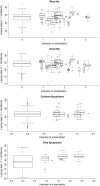Interspecific variation in the relationship between clutch size, laying date and intensity of urbanization in four species of hole-nesting birds
- PMID: 27547364
- PMCID: PMC4983601
- DOI: 10.1002/ece3.2335
Interspecific variation in the relationship between clutch size, laying date and intensity of urbanization in four species of hole-nesting birds
Abstract
The increase in size of human populations in urban and agricultural areas has resulted in considerable habitat conversion globally. Such anthropogenic areas have specific environmental characteristics, which influence the physiology, life history, and population dynamics of plants and animals. For example, the date of bud burst is advanced in urban compared to nearby natural areas. In some birds, breeding success is determined by synchrony between timing of breeding and peak food abundance. Pertinently, caterpillars are an important food source for the nestlings of many bird species, and their abundance is influenced by environmental factors such as temperature and date of bud burst. Higher temperatures and advanced date of bud burst in urban areas could advance peak caterpillar abundance and thus affect breeding phenology of birds. In order to test whether laying date advance and clutch sizes decrease with the intensity of urbanization, we analyzed the timing of breeding and clutch size in relation to intensity of urbanization as a measure of human impact in 199 nest box plots across Europe, North Africa, and the Middle East (i.e., the Western Palearctic) for four species of hole-nesters: blue tits (Cyanistes caeruleus), great tits (Parus major), collared flycatchers (Ficedula albicollis), and pied flycatchers (Ficedula hypoleuca). Meanwhile, we estimated the intensity of urbanization as the density of buildings surrounding study plots measured on orthophotographs. For the four study species, the intensity of urbanization was not correlated with laying date. Clutch size in blue and great tits does not seem affected by the intensity of urbanization, while in collared and pied flycatchers it decreased with increasing intensity of urbanization. This is the first large-scale study showing a species-specific major correlation between intensity of urbanization and the ecology of breeding. The underlying mechanisms for the relationships between life history and urbanization remain to be determined. We propose that effects of food abundance or quality, temperature, noise, pollution, or disturbance by humans may on their own or in combination affect laying date and/or clutch size.
Keywords: Breeding phenology; orthophotograph; passerine birds; population dynamics; urban heat island effect.
Figures


References
-
- Ahola, M. , Laaksonen T., Sippola K., Eeva T., Rainio K., and Lehikoinen E.. 2004. Variation in climate warming along the migration route uncouples arrival and breeding dates. Glob. Change Biol. 10:1610–1617.
-
- Arriero, E. , Sanz J. J., and Romero‐Pujante M.. 2006. Habitat structure in Mediterranean deciduous oak forests in relation to reproductive success in the blue tit Parus caeruleus . Bird Study 53:12–19.
-
- Barber, J. R. , Crooks K. R., and Fristrup K. M.. 2010. The costs of chronic noise exposure for terrestrial organisms. Trends Ecol. Evol. 25:180–189. - PubMed
-
- Blair, R. B. 1996. Land use and avian species diversity along an urban gradient. Ecol. Appl. 6:506–519.
LinkOut - more resources
Full Text Sources
Other Literature Sources

